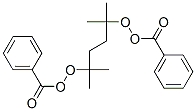-
Name
2,5-DIMETHYL-2,5-DI(BENZOYLPEROXY)HEXANE
- EINECS 220-050-9
- CAS No. 2618-77-1
- Article Data3
- CAS DataBase
- Density 1.143 g/cm3
- Solubility
- Melting Point
- Formula C22H26 O6
- Boiling Point 529.9 °C at 760 mmHg
- Molecular Weight 386.445
- Flash Point 229.5 °C
- Transport Information
- Appearance
- Safety
- Risk Codes
-
Molecular Structure
- Hazard Symbols
- Synonyms Benzenecarboperoxoicacid, 1,1,4,4-tetramethyl-1,4-butanediyl ester (9CI); Peroxybenzoic acid,1,1,4,4-tetramethyltetramethylene ester (7CI,8CI); 2,5-Hexanediol,2,5-dimethyl-, bis(peroxybenzoate) (8CI);2,5-Bis(benzoyldioxy)-2,5-dimethylhexane;2,5-Bis(benzoylperoxy)-2,5-dimethylhexane;2,5-Dibenzoylperoxy-2,5-dimethylhexane; 2,5-Dimethyl-2,5-bis(benzoylperoxy)hexane;2,5-Dimethyl-2,5-di(benzoylperoxy)hexane;2,5-Dimethyl-2,5-hexanedihydroperoxide dibenzoate; 2,5-Dimethyl-2,5-hexanediolbis(peroxybenzoate); 2,5-Dimethyl-2,5-hexanediol diperoxybenzoate;2,5-Dimethyl-2,5-hexanediyl bis(peroxybenzoate); 2,5-Dimethyl-2,5-hexanediylperoxybenzoate; 2,5-Dimethylhexane-2,5-diperoxybenzoate;2,5-Dimethylhexane-2,5-diyl diperbenzoate; Kayaester AB; L 118; Luperox 118;Lupersol 118; Perhexa 25Z; USP 711
- PSA 71.06000
- LogP 4.90100
Synthetic route
-
-
3025-88-5
2,5-dimethyl-2,5-dihydroperoxyhexane

-
-
98-88-4
benzoyl chloride

-
-
2618-77-1
2,5-dimethyl-2,5-di(benzoylperoxy)-hexane

| Conditions | Yield |
|---|---|
| With pyridine |

| Conditions | Yield |
|---|---|
| Multi-step reaction with 2 steps 1: H2O2 2: pyridine View Scheme |
-
-
2618-77-1
2,5-dimethyl-2,5-di(benzoylperoxy)-hexane

-
-
173282-40-1
5'-(tert-butyl)-[1,1':3',1''-terphenyl]-4'-amine

| Conditions | Yield |
|---|---|
| With n-butyllithium In tetrahydrofuran; hexane at -78 - 20℃; | 4.9% |
-
-
2618-77-1
2,5-dimethyl-2,5-di(benzoylperoxy)-hexane

-
-
178110-57-1
5'-(tert-butyl)-4,4''-dichloro-[1,1':3',1''-terphenyl]-4'-amine

| Conditions | Yield |
|---|---|
| With n-butyllithium In tetrahydrofuran; hexane at -78 - 20℃; | 3.3% |
2,5-Dimethyl-2,5-Di(Benzoylperoxy)Hexane Chemical Properties
Chemistry informtion about 2,5-Dimethyl-2,5-Di(Benzoylperoxy)Hexane (CAS NO.2618-77-1) is:
IUPAC Name: (5-Benzoylperoxy-2,5-Dimethylhexan-2-Yl) Benzenecarboperoxoate
Synonyms: 2,5-Dimethyl-2,5-Di(Benzoylperoxy)Hexane ; Varox Dcp-40c ; Varox Dcp-40ke ; Varox 230-Xl ; Varox 118 ; 1,1,4,4-Tetramethyltetramethylene Diperbenzoate ; 2,5-Dimethylhexane-2,5-Diyl Diperbenzoate ; 2,5-Dimethylhexane-2,5-Diperbenzoate
MF: C22H26O6
MW: 386.440002441406
EINECS: 220-050-9
Density: 1.143 g/cm3
Flash Point: 229.5 °C
Boiling Point: 529.9 °C at 760 mmHg
Enthalpy of Vaporization: 80.51 kJ/mol
Vapour Pressure: 2.59E-11 mmHg at 25°C
Following is the molecular structure of 2,5-Dimethyl-2,5-Di(Benzoylperoxy)Hexane (CAS NO.2618-77-1) is:

2,5-Dimethyl-2,5-Di(Benzoylperoxy)Hexane Safety Profile
Safty information about 2,5-Dimethyl-2,5-Di(Benzoylperoxy)Hexane (CAS NO.2618-77-1) :
RIDADR: 3102
HazardClass: 5.2
PackingGroup: II
2,5-Dimethyl-2,5-Di(Benzoylperoxy)Hexane Specification
2,5-Dimethyl-2,5-Di(Benzoylperoxy)Hexane is particularly sensitive to temperature rises and contamination. Above a given "Control Temperature" they decompose violently. It is generally stored or transported as a mixture, with an inert solid. To reactivity profile peroxides, such as 2,5-Dimethyl-2,5-Di(Benzoylperoxy)Hexane , are good oxidizing agents. Organic compounds can ignite on contact with concentrated peroxides. Strongly reduced material such as sulfides, nitrides, and hydrides may react explosively with peroxides. There are few chemical classes that do not at least produce heat when mixed with peroxides. Many produce explosions or generate gases (toxic and nontoxic). Generally, dilute solutions of peroxides (<70%) are safe, but the presence of a catalyst (often a transition metal such as cobalt, iron, manganese, nickel, or vanadium) as an impurity may even then cause rapid decomposition, a buildup of heat, and even an explosion. Solutions of peroxides often become explosive when evaporated to dryness or near-dryness. Danger of explosion when dry. May explode from heat, shock, friction or contamination. May ignite combustibles (wood, paper, oil, clothing, etc.). May be ignited by heat, sparks or flames.
Related Products
- 20,22-DIHYDRODIGITOXIN
- 20,29,30-Trinorlupane,(17alpha)-
- 20-ETHYL-6-β,8-DIHYDROXY-1-α-METHOXY-4-METHYLHETERATISAN-14-ONE
- 20-Ethylprostaglandin F2-alpha
- 20-Isopropylcholanthrene
- 20-METHYLCHOLANTHREN-15-ONE
- 20-METHYLCHOLANTHRENE PICRATE
- 20-METHYLCHOLANTHRENE-TRINITRO-BENZENE
- 20(S)-Ginsenoside C-K
- 2,10-DIFLUOROBENZO(rst)PENTAPHENE
- 26187-80-4
- 26188-15-8
- 26189-59-3
- 261896-35-9
- 2618-96-4
- 261903-03-1
- 261904-39-6
- 2619-06-9
- 2619-08-1
- 26191-63-9
Hot Products
About|Contact|Cas|Product Name|Molecular|Country|Encyclopedia
Message|New Cas|MSDS|Service|Advertisement|CAS DataBase|Article Data|Manufacturers | Chemical Catalog
©2008 LookChem.com,License: ICP
NO.:Zhejiang16009103
complaints:service@lookchem.com Desktop View